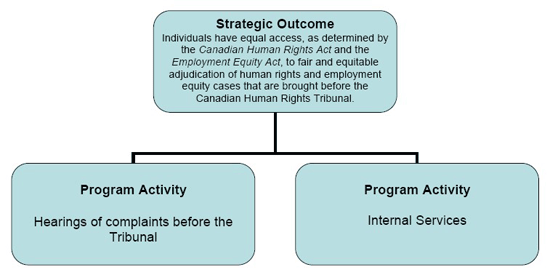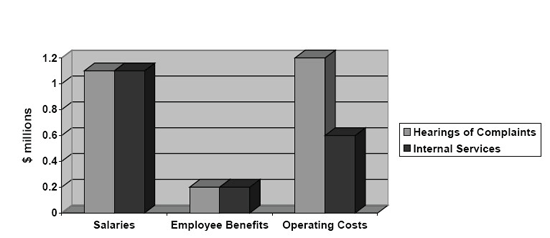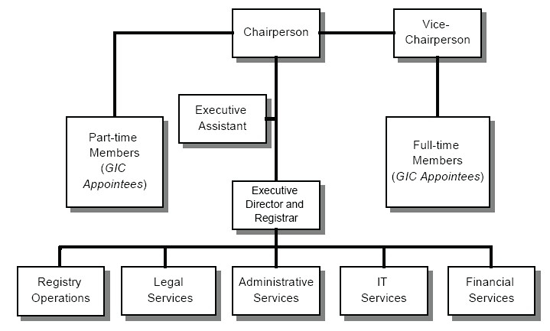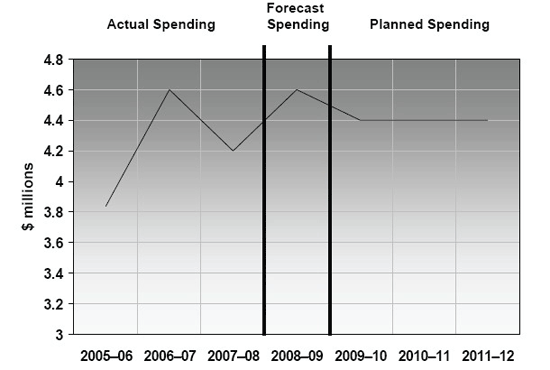Common menu bar links
Breadcrumb Trail
ARCHIVED - Canadian Human Rights Tribunal
 This page has been archived.
This page has been archived.
Archived Content
Information identified as archived on the Web is for reference, research or recordkeeping purposes. It has not been altered or updated after the date of archiving. Web pages that are archived on the Web are not subject to the Government of Canada Web Standards. As per the Communications Policy of the Government of Canada, you can request alternate formats on the "Contact Us" page.
Chairperson’s Message
The Government of Canada has set a goal to make Canada a diverse society that promotes linguistic duality and social inclusion. This is a tall order, achieved neither by magisterial edict nor by wishful thinking. The existence of federal and provincial human rights acts, commissions and tribunals, however, demonstrates our nation’s commitment to this lofty agenda.
As the custodian of a vital piece of Canada’s human rights protection machinery, the Canadian Human Rights Tribunal helps to define equality and normalize diversity. Through its written decisions of the past three decades it has helped diversify the federally regulated workplace and informed the jurisprudence that affects Canadian society generally in such areas as pay equity, discrimination and harassment on the basis of sex or sexual orientation, and the duty to accommodate persons with disabilities. Although the Tribunal does not promote human rights (that is the job of the Canadian Human Rights Commission), it does advance the aims of the Canadian Human Rights Act by providing a forum where human rights complaints can be scrutinized and resolved and by making the hard judgment calls that transport the Act from the statute books to the streets. The Tribunal will continue to focus on this objective over the coming years.
J. Grant Sinclair
Section 1: Departmental Overview
1.1 Raison d’être and Responsibilities
Raison d’être
The Canadian Human Rights Tribunal is a quasi-judicial body that hears complaints of discrimination referred by the Canadian Human Rights Commission and determines whether the activities complained of violate the Canadian Human Rights Act (CHRA). The purpose of the CHRA is to protect individuals from discrimination and to promote equal opportunity. The Tribunal also decides cases brought under the Employment Equity Act and, pursuant to section 11 of the CHRA, determines allegations of wage disparity between men and women doing work of equal value in the same establishment.
Roles and Responsibilities
In hearing complaints under the Canadian Human Rights Act (CHRA) and the Employment Equity Act (EEA), the Canadian Human Rights Tribunal considers matters concerning employment or the provision of goods, services, facilities or accommodation. The CHRA makes it an offence for anyone to discriminate against any individual or group on 11 grounds:
- race;
- national or ethnic origin;
- colour;
- religion;
- age;
- sex (includes pay equity, pregnancy, childbirth and harassment, although harassment can apply to all grounds);
- marital status;
- family status;
- sexual orientation;
- disability (can be mental/physical and includes disfigurement and past, existing or perceived alcohol or drug dependence); or
- conviction for which a pardon has been granted.
The Tribunal’s jurisdiction covers matters that come within the legislative authority of the Parliament of Canada, including those concerning federal government departments and agencies, as well as banks, airlines and other federally regulated employers and providers of goods, services, facilities and accommodation. The Tribunal holds public hearings to inquire into complaints of discrimination. Based on evidence and the law (often conflicting and complex), it determines whether discrimination has occurred. If it has, the Tribunal determines the appropriate remedy to compensate the victim of the discriminatory practice, as well as policy adjustments necessary to prevent future discrimination.
The majority of discriminatory acts that the Tribunal adjudicates are not malicious. Many conflicts arise from long-standing practices, legitimate concerns by employers, or conflicting interpretations of statutes and precedents. The role of the Tribunal is to discern the positions of the parties and establish fair and appropriate “rules” to resolve the dispute.
The Tribunal may inquire only into complaints under the CHRA that are referred to it by the Canadian Human Rights Commission, usually after a full investigation by the Commission. The Commission resolves most cases without the Tribunal’s intervention. Cases referred to the Tribunal generally involve complicated legal issues, new human rights issues, unexplored areas of discrimination or multi-faceted evidentiary complaints that must be heard under oath, especially in cases with conflicting evidence that involve issues of credibility.
The Tribunal is not an advocate for the CHRA; that is the role of the Commission. The Tribunal has a statutory mandate to apply the Act based solely on the evidence presented and on current case law. If there is no evidence to support an allegation, then the Tribunal must dismiss the complaint.
Organizational Structure
The Canadian Human Rights Tribunal is a small, permanent organization comprising a full-time Chairperson and Vice-Chairperson, and up to 13 full- or part-time members (see chart). Under the statute, both the Chairperson and the Vice-Chairperson must have been members of the bar for more than 10 years.
Tribunal Organization Chart
Members
To be eligible for appointment by the Governor in Council, all members of the Tribunal are required to have expertise in, and sensitivity to, human rights issues. In addition, members attend meetings for training and briefing sessions on such topics as decision-writing techniques, evidence and procedure, and in-depth analysis of human rights issues. Throughout their three- or five-year terms, Tribunal members are given opportunities for professional development.
Registry Operations
Administrative responsibility for the Tribunal rests with the Registry. It plans and arranges hearings, acts as liaison between the parties and Tribunal members, and provides administrative support. The Registry is also accountable for the operating resources allocated to the Tribunal by Parliament.
Legal, Administrative, Information Technology and Financial Services
Tribunal and Registry operations are supported by Legal Services, Administrative Services, Information Technology Services and Financial Services.
Legal Services provides the Tribunal with legal information, advice and representation.
Administrative Services provides support to the Tribunal in facilities management, communications, materiel management, procurement of goods and services, information management, security, reception and courier services. It also assists the Registrar’s Office in the development and implementation of government-wide initiatives, such as workforce representation, capacity-building, linguistic rights, stewardship and accountability.
The main priority of Information Technology Services is to ensure that the Tribunal has the technology required to perform efficiently and effectively. The section advises Registry staff and members on the use of corporate systems and technology available internally and externally, and offers training. The section is also responsible for ensuring system compliance with governmentwide technology policies and for ensuring system integrity, security and continuity.
Financial Services provides the Tribunal with accounting services, financial information and advice.
Human resources services are contracted out to Public Works and Government Services Canada.
1.2 Strategic Outcome and Program Activity Architecture

Strategic Outcome and Program Activity Architecture
1.3 Planning Summary
| 2009–10 | 2010–11 | 2011–12 |
|---|---|---|
| 4.4 | 4.4 | 4.4 |
| 2009–10 | 2010–11 | 2011–12 |
|---|---|---|
| 26 | 26 | 26 |
Summary Table ($ millions)
| Performance Indicators Tribunal decisions/rulings |
Targets Rendering decisions within four months of the close of the hearing, in 80% of cases |
|---|
| Program Activity1 | Forecast Spending 2008–09 |
Planned Spending | Alignment to Government of Canada Outcomes | ||
|---|---|---|---|---|---|
| 2009–10 | 2010–11 | 2011–12 | |||
| Hearings of complaints before the Tribunal | 2.7 | 2.5 | 2.5 | 2.5 |
Social Affairs |
| Internal Services | 1.9 | 1.9 | 1.9 | 1.9 | |
| Total Planned Spending | 4.6 | 4.4 | 4.4 | 4.4 | |
1 For program activity descriptions, please access the Main Estimates online at www.tbs-sct.gc.ca/est-pre/estimE.asp.
Contribution of Priorities to Strategic Outcome
The Tribunal’s priorities are largely dictated by its single strategic outcome. It will therefore continue to do what it does well: provide individuals equal access to fair and equitable adjudication of human rights and employment equity cases. Tribunal members will provide wellreasoned decisions and, where appropriate, order suitable remedies for those who have suffered discrimination. The Tribunal’s decisions will also provide guidance and direction to employers and service providers on the development of policies and practices that are consistent with respect to human rights. In addition to its usual business of conducting hearings, the Tribunal plans to pursue the priorities summarized in the table below.
The priorities that were identified in the Tribunal’s 2008–09 Report on Plans and Priorities have been determined to be more appropriately defined as initiatives for achieving priorities and have been moved to section 2 of this report.
| Operational Priorities | Type | Links to the Single Strategic Outcome and to Program Activity | Description |
|---|---|---|---|
| Continuous program improvement | Ongoing | PA: Hearings of complaints before the Tribunal | The Tribunal will continue to strive for increased inquiry process efficiencies to ensure complaint inquiries are conducted in an expeditious manner, as required by the Canadian Human Rights Act. |
| Managerial Priorities | Type | Links to the Single Strategic Outcome and to Program Activity | Description |
|---|---|---|---|
| Improved corporate management | Ongoing | PA: Hearings of complaints before the Tribunal PA: Internal Services |
The Tribunal will continue to research, develop and implement corporate and administrative efficiencies that will best support and enable an efficient and expeditious complaint inquiry process. |
1.4 Risk Analysis
The Tribunal’s main risk is the increased pressure on its resources from a generally increased and unpredictable workload, as well as the need to meet the obligations of government-wide horizontal initiatives.
From 1996 to 2002, the Canadian Human Rights Commission referred to the Tribunal an average of 44 human rights complaints each year. The Tribunal saw a dramatic rise in the number of new complaint cases, to 130 in 2003, with a further increase to 139 in 2004. The number of new cases dropped to 99 in 2005, to 70 in 2006 and then rose to 82 in 2007. The volume of referrals in 2008 is expected to rise again to 100 complaint files. This heavy workload, which is well above pre-2003 levels, is expected to continue into 2009 and 2010 and will continue to challenge the Tribunal’s resources.
Micro-agencies, such as the Tribunal, typically struggle with the additional resource demands posed by resource-intensive, yet necessary, horizontal government initiatives. The Tribunal is continuing work on several, such as strengthening its accountability framework and its information management capacity, planning for internal audit and evaluation policy implementation, and developing measures to enhance human resources management in the context of public service renewal.
Despite its very limited resources, the Tribunal plans to meet these daunting challenges over the next three fiscal years using a combination of operational and corporate strategies. Two 2005 initiatives address the risks from its workload challenges: a case management system for closely monitoring the pre-hearing phase of inquiries and the automated case management system, the Tribunal Toolkit. To ensure the continuity of the expertise needed for addressing the workload risk, the Tribunal is also planning to establish measures to enhance human resources retention, knowledge transfer and succession planning.
For achieving broader government-wide outcomes, the Tribunal will continue to actively seek opportunities both from new technologies and interdepartmental partnerships, sharing and collaboration. The Tribunal believes this approach will mitigate the pressure caused by horizontal initiatives while ensuring the Tribunal continues to be well positioned to carry out its mandate.
1.5 Expenditure Profile
Funding
The Tribunal is funded by annual appropriations from Parliament through a program expenditures vote for hearings and administrative operating expenditures. Main reference levels are not usually sufficient to cover costs for cases requiring inordinately long hearings, such as cases to determine allegations of wage disparity between men and women doing work of equal value in the same establishment (i.e., pay equity cases); Treasury Board submissions are prepared as required to obtain additional funding for these cases.
Departmental Spending Trend
Spending trends have remained relatively constant over time. Amounts shown in this report do not include services provided without charge by other government departments and agencies of approximately $1.2 million per year for accommodation provided by Public Works and Government Services Canada and for government payments to employee insurance plans. The increase in actual spending from 2005–06 to 2006–07 resulted from salary expenses in relation to retirement and parental benefits and from increased operating costs because of an increase in the number of hearing days held. At the time this document was prepared, it was forecast that the annual appropriation amount for 2008–09 would be spent. The majority of expenses are for employee salaries and benefits, conducting hearings, and maintaining the internal services that provide the infrastructure that supports the Tribunal’s single program.
Program Activity 2009–10 Planned Spending

Program Activity 2009–10 Planned Spending
| Vote # or Statutory Item (S) | Truncated Vote or Statutory Wording | 2008–09 Main Estimates |
2009–10 Main Estimates |
|---|---|---|---|
| 15 | Program expenditures | 4.0 | 4.0 |
| (S) | Contributions to employee benefit plans | 0.4 | 0.4 |
| Total Tribunal | 4.4 | 4.4 |


